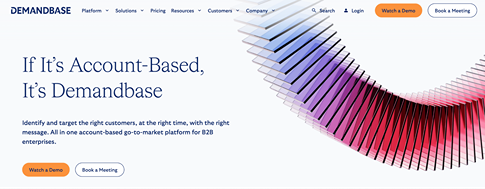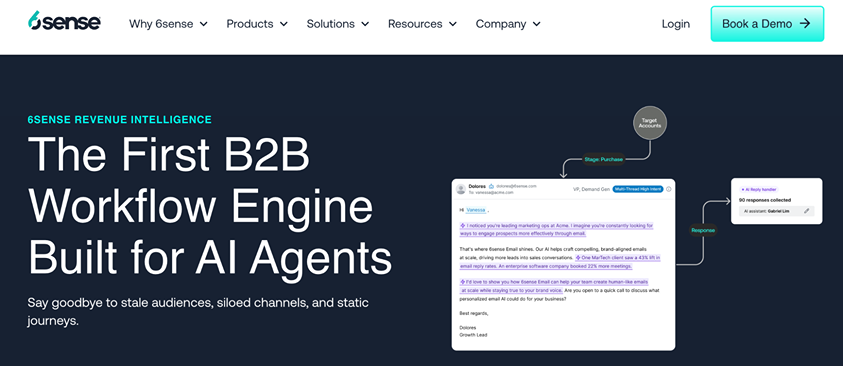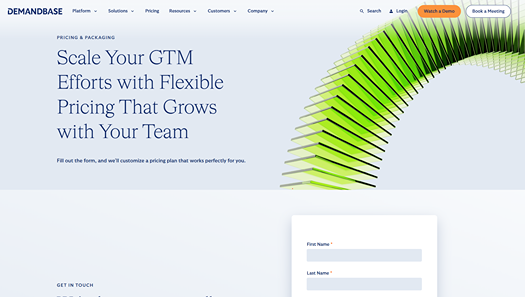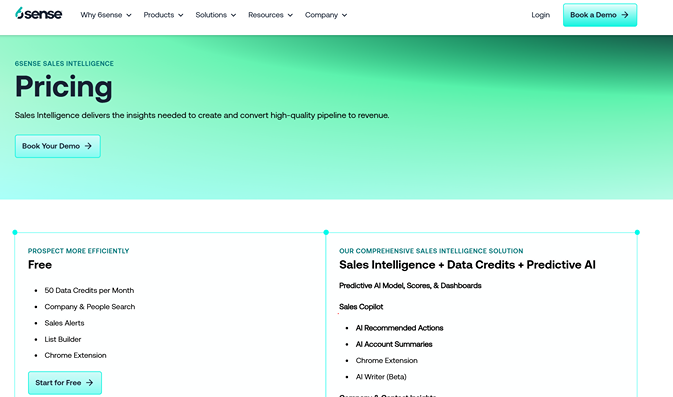Demandbase and 6sense both promise sharper deal flow, yet they start from opposite ends of the ABM map. Demandbase puts heavy weight on rich account data and broad ad reach, while 6sense spots faint buying clues early and tells teams the best time to act.
The choice comes down to whether you value complete profiles or perfect timing. Here’s a breakdown of the most important key differences:
Focus
Demandbase calls itself an “account intelligence” suite; it merges CRM facts with firmographic and intent data to form one record per company.
6sense centres on prediction; its model sorts search terms, content views, email clicks, and other traces to flag in-market accounts.
Data
Demandbase watches over three million sites, tracks 550k keywords, and captures one trillion+ + intent signals each month. These figures feed ads and web personalisation.
6sense relies on CRM traffic and open-web events; its volume sits lower, yet the model weights every clue to rank urgency.
Moment edge
Demandbase favours reach first; ads and site pages adjust the instant a named account appears.
6sense values the precise moment; dashboards mark hot, warm, and cold accounts so reps aim effort where a deal looks close.
Ease of use
G2 reviewers praise Demandbase for an interface that teams grasp quickly and turn into action.
Many reviewers report a steeper curve with 6sense, though they credit the tool with deeper insight once mastered.
Pricing
Demandbase states a platform fee plus a flat user fee, yet no public list exists; market data pegs the median deal near $62k a year.
6sense starts with a light free tier of 50 credits; paid deals often begin around $120 k for year one and require a two-year contract.
Which one should you use?
Pick Demandbase for a full account view, quick ramp-up, and multi-channel ads.
Pick 6sense for sharp intent cues, precise timing, and a budget that covers the higher entry cost.
Exploring Demandbase vs. 6sense
Demandbase Overview

Demandbase is a cloud-based Account Based Marketing (ABM) platform that calls itself an “account intelligence” tool, helping sales and marketing teams work together on various tasks. How does this work? This platform leverages data and AI-powered insights by integrating with your CRM data and marketing resources.
Then it combines this information with specific data about your audiences: business contacts, technographics, firmographics, and purchase intent, to name a few. Demandbase gathers this data from a vast range of sources and consistently updates its account intelligence model to deliver the most up-to-date information for intent data, account targeting, and personalization tools.
6sense Overview

6sense is one of the original AI-powered ABM services and claims to be the only ABM platform powered by Revenue AI. This platform identifies the best targets through an analysis of the customer relationships in your CRM and your website’s traffic data.
In effect, 6sense can help a business’s sales team drive their company’s revenue growth by first identifying accounts that may want to buy, then assisting the user with crafting the right message to reach these buyers, and then finally planning a meeting – all automatically for their customers. This is done by understanding the behaviors of these potential buyers and then engaging them with the right message at the right time.
What’s the Difference Between Demandbase and 6sense?
Both platforms can integrate with most CRMs and handle the functions needed in an ABM platform. Demandbase, however, is a great option for businesses looking for an end-to-end solution for their sales and marketing teams so that they can collaborate in one place. 6sense, on the other hand, focuses more on businesses interested in leveraging their AI-driven insights to drive revenue growth. The main differences are below:
Demandbase:
- Accurate intent data using a tool that tracks more than one trillion intent signals every month from their proprietary B2B demand side platform to better understand and predict buying behaviors.
- Users can add custom tags and fields and gain access to data from several partner sources to enhance the extent of the data.
- Recognizes keywords and data signals in more than 100 languages to support global marketing and advertising personalization.
6sense:
- Intent data and predictive analytics to help businesses target specific buyers’ preferences, behaviors, and purchase goals.
- An AI engine that identifies and prioritizes high-potential accounts for sales and marketing endeavors.
- Assists with campaigns and messaging through a variety of channels – email, social media, and advertising platforms.
Demandbase vs. 6sense at a Glance
Before we dive into these platforms’ specific benefits, here’s a side-by-side comparison of Demandbase and 6sense in general:
| Demandbase | 6sense | |
| Use Cases | Predictive analytics, Intent Data, Personalized emailsReal-time dataMulti-channel outreach, Custom segmentation, Chrome extensions | Revenue AI identifies accounts ready to buy immediately |
| Database Size & Reliability | Tracks more than one trillion intent signals every month from their proprietary B2B demand side platformQuality of account data is impressive overall | 400 million B2B buyer profiles65 million company profiles from more than 200 countries60 million phone numbers100 million email addressesNumerous validation levels for reliability |
| Data Enrichment Features | Advanced account-level advertising capabilities | Data focused on sales and marketing enrichment |
| Lead Management | Targeting abilities help businesses deliver personalized experiences to individual accounts | Personalized messages for potential leads |
| AI Features | AI-powered insights identify who, how, when, and where to target potential customers | Predictive analytics, Intent, Personalized emailsReal-time dataMulti-channel outreach, Custom segmentation, Chrome extensions |
| Integrations | Integrates with a wide variety of CRM systems, like Salesforce and HubSpot, and Marketing Automation Systems like Marketo and Eloqua; allows integration with multiple Marketing Automation Systems but only one CRM | CRM integrations using built-in platforms like Microsoft Dynamics and SalesforceIntegrates with marketing tools like HubSpot, Marketo, and PardotIntegrates with social media platforms like LinkedIn and Facebook, along with Google Ads |
| Ease of Use | Yes | Known to be complicated |
| Compliance | Meets industry security and compliance standards | Meets industry security and compliance standards |
| Browser Extension | Chrome | Chrome |
| Free Access? | No | Yes |
Noteworthy Features of Demandbase vs. 6sense
There are key features of both Demandbase and 6sense that set the tools apart from other ABM platforms.
Demandbase Key Features
Demandbase is an all-in-one account-based go-to-market platform with the following features:
- Account-based advertising – This is where Demandbase really shines, as it’s the only platform with a combination of intent-based, people-based, and IP-based targeting to ensure you reach the right targets and advertise on brand-safe websites.
- Predictive analytics and accurate intent data – See who is interested in your company by tracking more than one trillion intent signals every month with Demandbase’s proprietary B2B demand-side platform. This includes those who were once “anonymous” sources.
- Technology integrations – Easily set up CRM, MAS, and other platform integrations with popular platforms like Salesforce, Hubspot, Microsoft Dynamics, and Google Analytics.
- Orchestration – Manage audiences on numerous social media platforms and marketing automation platforms, and create routines to automatically update people and account data.
- Automatic sales activity tracking – Automatically sync your activity from email inboxes and calendars directly into Demandbase One to get a complete picture of all activity and improve predictive models and sales alerts.
- Account intelligence – View accounts pulled from Demandbase’s data, third-party sources, web activities, and your own CRM and marketing automation platforms.
- Website personalization – Provides custom web experiences for accounts based on their behavior and engagement to boost your personalization and make engagements more meaningful.
6sense Key Features
As noted above, the features of 6sense focus more on using AI for predictive analytics and behavior tracking:
- Predictive analytics and intent data – Predictive analytics help users time their campaigns based on where their potential buyers’ specific interests are, while intent data helps users focus on prospects with the strongest intent. This is a main selling point of 6sense.
- Online behavior tracking – By tracking the online behavior of potential buyers, 6sense can ensure you identify exactly when a prospective buyer is ready to actually make a purchase.
- Personalized emails – 6sense crafts conversational emails that can be personalized for leads, saving time for the marketing and sales team while driving engagement.
- Real-time data –6sense provides access to real-time contact and company data.
- Multi-channel outreach and custom segmentation – From email to advertising, 6sense automates cross-channel outreach and detailed audience segments for better marketing campaign performance.
- Chrome Extensions – Account insights are delivered directly within B2B websites, such as LinkedIn, through a handy Chrome Extension.
- Prioritization dashboards – These provide users with an at-a-glance view of which accounts are ready for personalization and engagement.
Data Sources & Accuracy
Both Demandbase and 6sense claim to have accurate, detailed, actionable data that users can rely on when using their services. Here’s how they stack up:
Demandbase Database
The Demandbase database is impressive, drawing from more than one trillion monthly interactions and 36 billion B2B site visits to help your sales and marketing teams identify and prioritize accounts. They also use AI and machine learning to identify once-anonymous accounts so that they’re no longer nameless prospects. Company information is drawn from more than 40,000 sources, and B2B contact data helps connect you with the decision-makers in the company. This is in addition to intent data and technographics to help you focus on the right accounts for your company.
6sense Database
The 6sense database has more than 400 million B2B buyer profiles, 65 million company profiles from across more than 200 countries, 60 million direct-dial phone numbers, and 100 million verified email addresses. Accuracy is key here, as all of this data is stored on buyer profiles that pass through numerous validation levels and are continuously vetted for correct contact informationCompanies can use their B2B account and contact data search engine to engage with prospects that meet their specific needs.
Pricing & Plans
Here is a problem with both platforms – neither Demandbase nor 6sense are transparent with their pricing.
Demandbase Cost
Demandbase offers the following services: Demandbase One — heir flagship account-based GTM platform — Advertising, and Data. Demandbase claims that their pricing model features a clear platform fee that covers the essential software and services you need. However, they are not transparent as to what that “clear” platform fee actually is for users.
They also state that there is a flat fee per user, but again do not specify this flat fee cost. This makes it difficult to compare Demandbase with other platforms’ pricing structures. Although reviewers have claimed this service is priced competitively, it is unclear on their site.

6sense Cost
6sense has a tiered pricing structure for their service plans: Free, Team, Growth, and Enterprise. Yes, there is a free version here for individuals and small teams just starting their prospecting efforts. However, if your company is looking to build data-driven account lists, you will want one of the other plans — all of which have custom pricing
The 6sense Chrome extension is available with all four plans, but their free plan is limited to only 50 credits per month. This is very limited if you want to use 6sense for prospecting, yet upgrading is rumored to clock in at a massive cost of $120,000 for the first year with a required two-year commitment. But again: it’s difficult to discern what a company can expect to spend when none of that pricing is clearly listed on the site.

Integrations for Demandbase vs. 6sense
Both Demandbase and 6sense offer a wide range of integration options, but there are significant differences in their methods and competencies:
Demandbase Integrations
Demandbase offers CRM integrations with some of the most popular platforms, including Salesforce, HubSpot, Microsoft Dynamics, Google Analytics, and Adobe Analytics. These integrations allow you to seamlessly connect Demandbase to your CRMs.
You can also integrate with multiple Marketing Automation Systems as long as they are different platforms (for example, Marketo and Eloqua), but Demandbase only allows you to integrate with one chosen CRM, despite its capabilities to integrate with numerous CRM options.
6sense Integrations
6sense also has impressive CRM integrations through seamless data synchronization using built-in integration platforms like Microsoft Dynamics and Salesforce. This integration platform allows users to effortlessly leverage the company’s predictive analytics and account identification competencies directly within their CRM. Similar to Demandbase, 6sense also integrates with many popular marketing tools like HubSpot, Marketo, and Pardot so users can coordinate a multi-channel messaging campaign to target specific accounts. Integrations also include popular social media platforms so that users can target high-priority accounts with personalized ads via LinkedIn, Meta, and Google Ads.
Implementation & Customer Support
Usability is key to any business intelligence tool, and both Demandbase and 6sense tout their ease of user experience and implementation. Let’s see if they are as easy to use as they claim.
Demandbase Usability
This is where Demandbase surpasses 6sense, as numerous users have noted that the platform is straightforward to use and integrate with their existing systems. The interface is well-organized and customizable, which means you can tailor the dashboard to your company’s specific preferences. Not only that, but the customer support is purportedly both responsive and proactive.
6sense Usability
Users have noted that the dashboards for 6sense are overwhelming, and for those without experience with advanced ABM platforms, the learning curve is even steeper. This means gaining an understanding of some of the more complex features of 6sense, although very useful, will take some time for the average user. The platform itself was designed to be user-friendly, but navigating through the setup process and then leveraging the full interface could take some time to get used to in everyday business settings.
Reviews of Demandbase vs. 6sense
What do actual users say about Demandbase and 6sense? We examine a few user reviews below.
Demandbase Reviews
The reviews on G2 are overwhelmingly positive for Demandbase, with one reviewer claiming it’s the “best ABM platform in the market.” With more than 1,000 5-star reviews, users focused positively on the platform’s identification and prioritization of targeted accounts and on high-value businesses for their marketing teams. In line with the above section, nearly all users praised the ease of use for this ABM platform.
The negative reviews were few and far between, with some users saying the platform doesn’t work well with Google Chrome (for which it has a browser extension) and others complaining that the algorithms need work. However, these complaints are a few years old, suggesting that Demandbase might have since improved these features.
6sense Reviews
It seems larger, mid-range companies with between 51-1000 employees had very positive reviews about 6sense. 6sense had more than 600 5-star reviews on g2 and only 9 1-star and 2-star reviews on the site. The consensus was that 6sense is the go-to platform for sales and marketing, with one reviewer saying their marketing team uses 6sense every day.
6sense was also called a “game changer” for its Revenue AI for Marketing. Not only do users find it helpful to boost lead conversion rates, enhance marketing ROI, and streamlining the sales pipeline. As for the 6sense Revenue AI for Sales, they noted that its capabilities are easy to set up and then to prioritize sales efforts depending on what accounts are “hot, warm, and cold.”
Although these mid-range companies found 6sense to be a game-changer, larger Fortune 500 companies complained that using 6sense to pinpoint location-based accounts was difficult. There was also a recommendation that 6sense integrate with Outlook email, along with a complaint that it has slower-than-usual refreshes of the website data.
Demandbase vs. 6sense Pros & Cons
On one hand, Demandbase has proprietary intent data that integrates with third-party sources to provide a complete analysis of account intent. On the other hand, 6sense’s predictive analytics uses AI to analyze millions of behavioral signals from a variety of sources – content engagement, sales efforts, web activity, and email responses.
Overall, both platforms target specific accounts and prioritize potential buyers, with Demandbase using lead scoring and 6sense using predictive capabilities.
Demandbase
Personalization is one of the key advantages of Demandbase, although it lags slightly in advanced data analytics compared to 6sense.
Pros:
- Personalization
- Integration with apps like LinkedIn
- Easy-to-use and well-organized interface
- Smooth onboarding process
- Targeting global accounts
- Advanced account targeting
- Flexible pricing
Cons:
- Limited predictive analytics and AI-powered insights
- Awkward and cumbersome management of larger numbers of accounts
- Primitive segmentation and identification of potential buyers
6sense
As noted, using AI for advanced predictive analytics is where 6sense excels.
Pros:
- More advanced predictive analytics
- Account targeting and engagement of potential customers
- Customizable segments using AI and predictive capabilities
- Detailed buyer insights
- Effective audience segmentation and buyer identification
- Seamless CRM integration with numerous platforms
Cons:
- Expensive
- Difficult interface and learning curve
- Data overload
Which to Choose: Demandbase or 6sense
Both Demandbase and 6sense are top ABM platforms that have impressive features, from the collection of intent data and personalization to account targeting and sales and marketing tools. However, neither platform is transparent with its pricing, and each has areas of strength that may serve companies differently.
If your sales and marketing team is not tech-savvy but still wants customization for targeted ABM at a reasonable price, then Demandbase may be the right fit. Demandbase is better suited for companies that focus on account intelligence, personalization, and need a one-stop shop for the collaboration of sales and marketing teams. There are also features for communicating globally with clients, and customers claim that their pricing structures are more competitive than 6sense.
However, if you want more advanced predictive analytics and intent data that uses AI to analyze millions of behavioral signals (and price is not an issue), then 6sense has a stronger edge over Demandbase. While Demandbase is well-known for its impressive ABM capabilities, 6sense is an all-in-one ABM platform that produces actionable insights for users.
Choose Demandbase for specific marketing and advertising features to target and personalize individual accounts and to enhance ABM campaigns.
Choose 6sense for a greater focus on predictive analytics, tailored towards more experienced users of AI and intelligence platforms, and those with larger budgets.
Take Your Business Further With UpLead
Demandbase and 6sense offer some appealing capabilities, but they’re not the only options — especially where cost is concerned. UpLead is much more transparent in its pricing than both Demandbase and 6sense and offers a seven-day free trial. After their free trial, UpLead has very competitive pricing structures: $99 a month for its Essentials plan and $199 a month for the Plus plan.
UpLead is also well known for its 95% accuracy rate for emails, which it achieves through a combination of human and machine-learning email verification processes. These results ensure your outreach efforts are more effective. UpLead also has a user-friendly platform, real-time email verification for higher-quality leads, and access to over 160 million contacts worldwide.
Experience the power of high-quality leads and an easy-to-use platform: give UpLead a try today for free.





